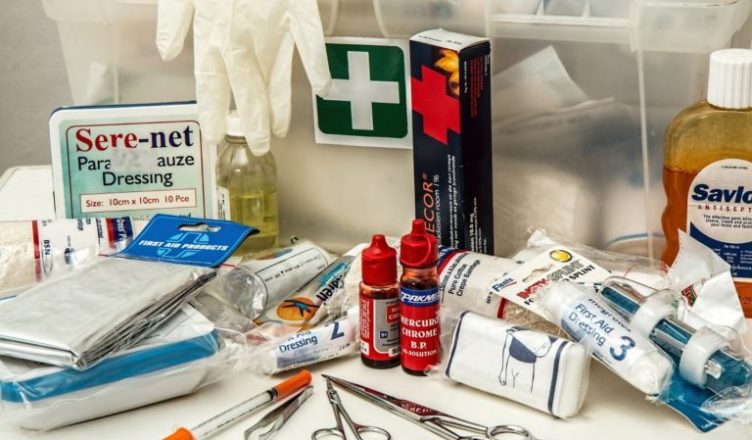As a prepper, one of the most important things you can have on hand is an ultimate survival first aid kit. Although prepackaged kits are available in almost any pharmacy, relying on them will leave you ill-equipped if the SHTF.
The following lists will help you create your ultimate survival first aid kit. They are extensive, but not all-inclusive. You will have to add items for special needs you, your family, or even your pets may have. Use your best judgment on quantities. However, keep in mind a rule many preppers follow – two is one, and one is none.
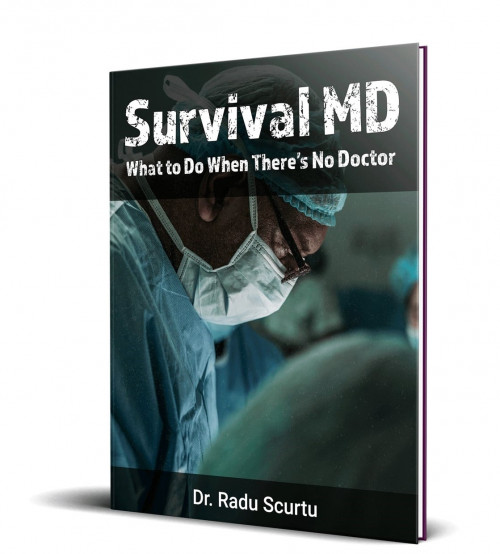
The descriptions and comments within the lists are not medical advice. If you want to be prepared if the SHTF, learn ahead of time how and when to use all the items in your kit and PRACTICE with them. A chest seal looks simple, but there is an art to handling and applying them. Celox Granules are a nightmare in the wind or in rotor down-wash, they are an eye, and throat irritant and take 2-3 minutes to clot whereas the Rapid (or Ribbon) are much easier for the non-professional to handle.
Knowing how to use your medical items can NOT be over-stressed.
Primary Components of the Ultimate Survival First Aid Kit
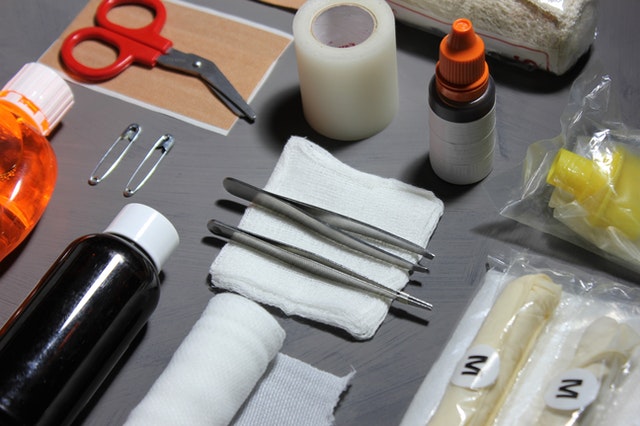
In addition to the items below, include a comprehensive first aid reference manual. Make sure it’s a paper copy. If the SHTF you could be without power, making electronic versions inaccessible. Being able to look up a medical situation you’re not familiar with can make all the difference to the person you’re trying to help.
Each item is linked out so you can purchase it if needed.
| Item | Simple Description/Comments |
| Adhesive bandages | Get self-adhesive. |
| Alcohol pads/antiseptic solution | Used to sterilize areas around wounds. |
| Antibacterial soap | For cleaning wounds, hands or anything else that gets dirty or contaminated. Buy high quality grade. |
| Antibiotic ointment | Reduces the chance of infection. |
| Antifungal ointment | Treats fungus infections that thrive in wet and humid conditions |
| Battle dressing | For traumatic wounds where bleeding is profuse. |
| Blood clotting powder | May stop or minimize bleeding, especially in people who are on blood thinners. |
| Burn gel | Helps alleviate pain associated with burned skin. |
| Butterfly bandages | Used to close lacerations. |
| Compression bandages | Used to treat sprained joints. Stock different sizes so you can wrap any joint. |
| Cotton balls/pads/swabs | Cleans wounds and applies ointments. Stock an assortment of styles and sizes. |
| CPR barrier/masks | For protection against exposure to infection. |
| Eye solution/wash | Saline-based, helps remove debris from the eye. Used regularly can keep eyes clean. |
| Foot powder | An alternative to antifungal cream. Powder lasts longer and is easy to apply. |
| Gloves | Protects against contamination and any blood-borne diseases. If latex allergy is a concern, non-latex gloves are available. |
| Hand sanitizer | De-sanitizes hands and skin. Not recommended for open wounds. |
| Hydrocortisone cream | Helps the body recover from insect bites or stings and minor rashes. |
| Hydrogen peroxide | Helps treat gum discomforts. |
| Instant hot/cold packs | Helps reduce pain and swelling. Stock different varieties and sizes. |
| Irrigation syringe | For cleaning wounds. A squeeze bottle is a good alternative. |
| Large cloth dressings | To protect wounds. 5×9 inches is a good size since they can be cut down as needed. |
| Medical tape | Used to secure bandages or to hold medical equipment in place. Try to stock waterproof or water-resistant. |
| Oral thermometer | For detecting fevers. |
| Petroleum jelly | For the dressing of burns and small cuts to prevent reinfection or dirt from entering. Can also retain moisture in the skin, especially when it’s too cold. Help keep heat inside the body. |
| Roll bandages | Have various uses and can be cut into different sizes as needed. |
| Scalpel | Used for minor surgery or to remove excess tissue. Surgical grade scalpels are best. |
| Sewing needles | Helpful for dislodging foreign matter from under the skin. |
| Sharp scissors | Cuts bandages and other materials. Have more than one set. |
| Splinting material | There are a variety of materials and most can be cut to the size needed. |
| Sterile gauze pads | Covers wounds. Have a variety in the kit. |
| Superglue | Used as a waterproof, invisible bandage for small cuts, blisters, and abrasions. Also used for more significant wounds instead of stitches. |
| Sutures | Used to close severe wounds. Good suture size is a 3-0 and above since smaller sizes might not be sufficient. If possible, have different sizes on hand. |
| Syringes | Can inject or withdraw fluid as necessary. |
| Tourniquets | When used appropriately, can reduce or stop the blood flow through a vein or artery by compressing a limb. |
| Triangular bandages | Suitable for immobilizing dislocations and fractures. |
| Tweezers | Most often used to remove splinters or other tiny objects. |
| Wooden tongue depressors | Used for checking throat obstructions and for splinting small fractures. |
Equipment and Kits for Your Ultimate Survival First Aid Kit
The following list of equipment and kits will assist you in administering first aid in critical situations.
| Item | Simple Description/Comments |
| Automated external defibrillator (AED) | Small, battery-operated unit used for starting a failed heart during cardiac arrest. |
| Blood pressure cuff | Used to monitor blood pressure. |
| Burn kit | For severe burns, or burns located on more than one part of the body. |
| Cervical collar | Immobilizes a neck due to a neck or spine injury. |
| Dentist kit | Items in the kit include temporary treatments for lost fillings, caps and crowns. |
| Foldable stretcher | Enables the carrying of an injured person. |
| Locking forceps | Used in combination with suturing. They can also stop hemorrhaging blood vessels. |
| Oral airways | Keeps a person’s airway open. |
| Snakebite kit | Generally includes an extractor pump that pulls venom from pooled areas in the body. Cannot extract venom already in the circulatory system. |
| Stethoscope | Verifies breathing and heartbeat. |
| Suture kit | Contains a variety of items you need for suturing wounds. |
Essential Medications for Your Ultimate Survival First Aid Kit
Include these medications in addition to any pharmaceuticals prescribed by your doctor for ongoing medical conditions. If the SHTF, you may not be able to get to any doctor, or to any pharmacy. So stock in sufficient quantities.
| Item | Simple Description/Comments |
| Acetaminophen | Reduces pain and fever. |
| Antacid | Temporarily relieves stomach and gastrointestinal pain. |
| Antihistamine | Alleviates mild allergic reactions. |
| Aspirin | Common painkiller and is also used to treat certain heart conditions. |
| Asthma inhalers | If you or a family member have asthma, put one or two in your kit and leave them in there. |
| Broad spectrum antibiotics | Act on a wide range of diseases. Are used when the source of infection is unknown. |
| Cephalexin | Heavy-duty antibiotic good at treating staph infections and other bacterial infections. |
| Diarrhea treatment | Controls diarrhea and can prevent dehydration. |
| Dramamine | Used to treat symptoms usually associated with motion sickness. |
| Epipen or other allergy medication | Prescribed for people prone to anaphylactic reactions from insect stings or certain foods. |
| Ibuprofen | Is an anti-inflammatory and analgesic. |
| Insulin | If you or a family member has diabetes, ensure your kit includes a good supply of insulin and needles to administer it. |
| Nitroglycerin | This is a treatment for patients with heart conditions. |
| Prednisone | Is an immunosuppressant and used to treat some inflammatory and autoimmune diseases. |
| Stool softener | Treats or prevents constipation. |
| Sugar pills | Can quickly raise the blood sugar of a person who has diabetes. |
| Throat lozenges | Soothes throat pain. |
Handy Herbals for Your Ultimate Survival First Aid Kit
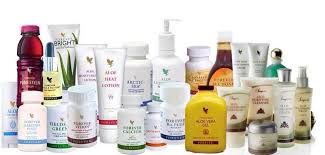
There are many oils, herbals and other natural remedies available. This list provides a few that may prove very helpful in a survival situation.
| Item | Simple Description/Comments |
| Aloe Vera | Treats skin-related problems and burns. |
| Cranberry extract | Primarily used to treat urinary tract infections. |
| Clove bud oil | Alleviates tooth and gum pain. |
| Lavender oil | Helps heal burns and wounds. |
| Peppermint oil | Can release tight muscles. Mixed with lavender oil can reduce itching caused by rashes or poison ivy. |
Rounding Out Your Ultimate Survival First Aid Kit
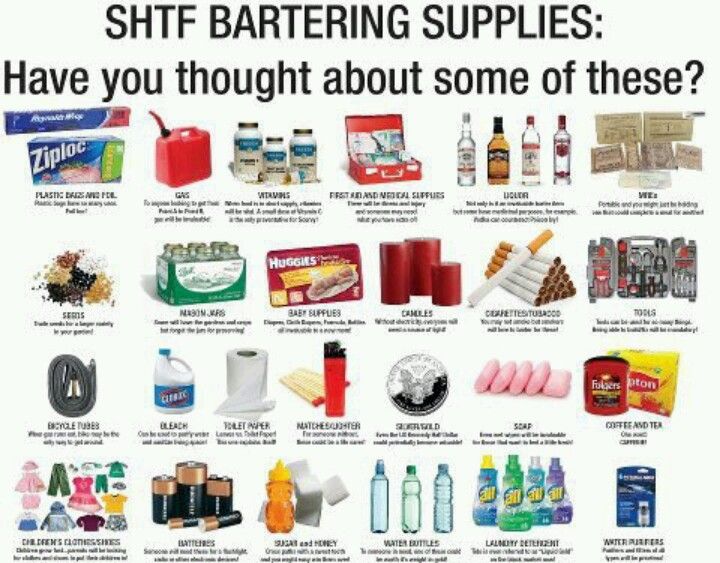
This list supports or enhances other items contained in your survival first aid kit. Pack enough for yourself, and some to barter with. Bartering materials are valuable if the SHTF.
| Item | Simple Description/Comments |
| Aqua tabs | Cleans and purifies water in minutes for drinking, cooking and bathing. |
| Baking soda | Provides relief to bee stings and can draw out excess pus from a wound. |
| Batteries | If you have flashlights or transistor radios or even portable ham radios, have extra batteries on hand in the appropriate sizes. |
| Cotton sheets | Used to create makeshift stretchers. |
| Emergency blankets | Useful in cold weather and for preventing any victim from going into shock. |
| Ensure | Can help with nutritional needs. Some products come in powder form for easy storage and transport. |
| Extra broad spectrum antibiotics | Antibiotics may be one of the most needed medications in your kit. |
| Flashlights | Stock several of these in different brands and styles. It’s helpful if they use the same size batteries. Include a headset type if possible. |
| Hot water bottle | Filled with water, can reduce muscle pain and provide warmth if needed. |
| Lip balm | Treats and prevents chapped and cracked lips. |
| Magnifying glass | Used to see foreign objects embedded into skin making them easier to remove. |
| Pedialyte | Replaces fluids and minerals after a bout of vomiting or diarrhea. Comes in powder form for light and manageable storage. |
| Pen/pencil and paper | Recording vital signs may become essential. You want to track them so you can gauge improvement or deterioration in someone’s condition. |
| Plastic bags | Used to dispose of contaminated medical waste. Can also double as irrigation devices by poking a hole in a corner. Resealable are best. |
| Pregnancy test | Knowing if someone is pregnant can ensure proper nutrition. |
| Sunscreen | Prevents sunburn. |
Using and Maintaining Your Ultimate Survival First Aid Kit
Now that you have all the items assembled, you have a few more steps.
- Place items in a durable, waterproof bag. Some have liners inside.
- Create a list of what’s in the bag, along with any expiration dates. Check the list at least twice a year. Replace anything that that’s missing or expired. Refill medications ahead of time.
- Become as familiar as possible with the medical kit inventory.
It’s vital that you and all the members of your family learn how to use the items in the kit. Otherwise, they are of no benefit to anyone. Keep in mind that there are common and uncommon uses for items in your medical inventory. So learn as much as you can about each thing.
With this kit you will be as prepared as you can be if the SHTF.

source : Guest Contributor

